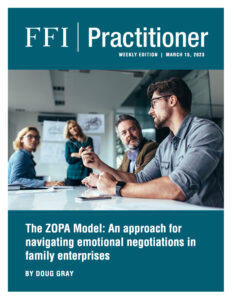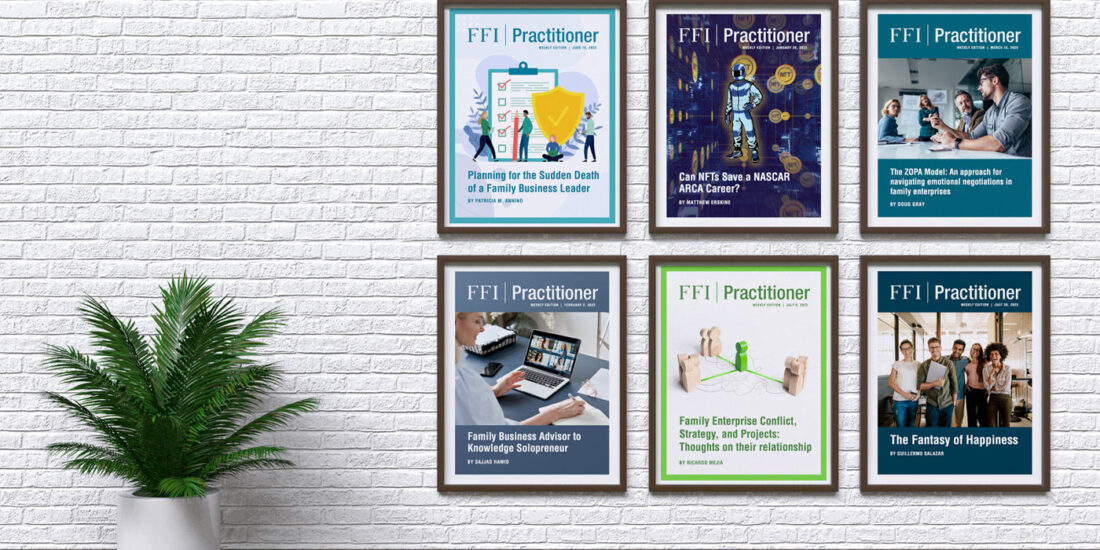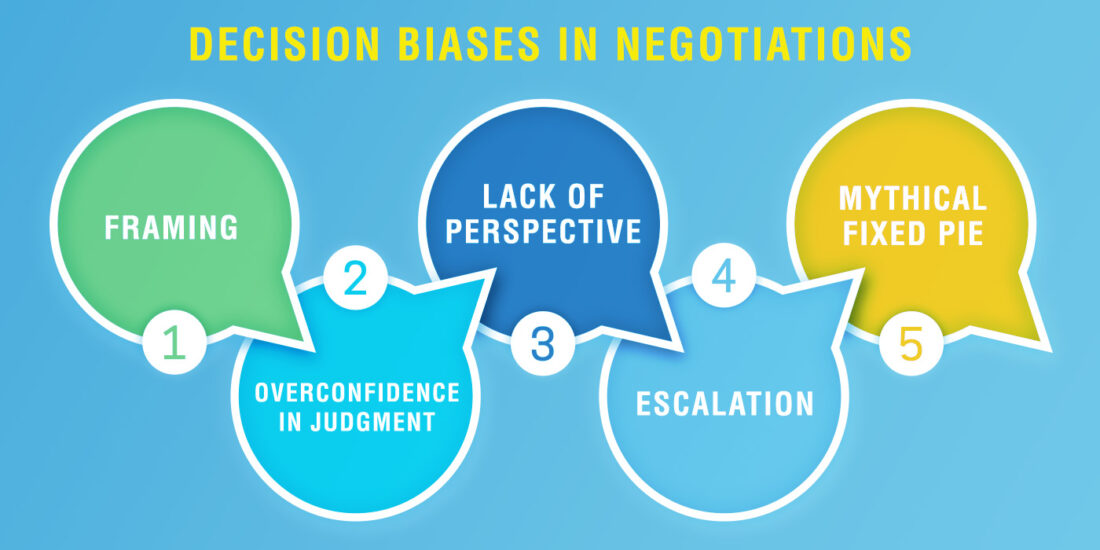
View this edition in our enhanced digital edition format with supporting visual insight and information.
Thank you to this week’s contributor, Doug Gray, for providing an overview of a model that can help your family enterprise clients negotiate emotional topics. The ZOPA model aims to help family members identify their non-negotiables as well as finding the “Zone of Possible Agreements” to achieve solutions that may be mutually beneficial to all parties involved.
Negotiations within family enterprises are usually emotional events. How could they be anything else? People are emotional. When we practice emotional responses to Uncle Bill or sister Sarah, we are reinforcing neural patterns. Those “old stories” can prevent family members from effective decision-making. Family enterprise clients may need to explore utilizing a new model.
In MBA programs, students learn about negotiation models that lean toward rational decision-making. The BATNA (Best Alternative to a Negotiated Agreement) model often has limited utility in complex emotional systems. The “Take It or Leave It” model ignores options and counteroffers. “Threats and Warnings” are power-based tactics that need to be identified and defused. For decades, I have used the ZOPA model with emotional family systems, and I believe that there are lessons for advisors that can be learned from the experiences of diplomats and crisis negotiators who often use this approach.1 I hope that this short article, designed for practitioners who need to accelerate change or reduce emotional conflicts, will be useful.
ZOPA is defined as the Zone of Possible Agreements. Think of the ZOPA as a list in the middle column between two parties with non-negotiables, as outlined below:2
Figure 1: The ZOPA Model

Family enterprise clients can struggle to achieve productive outcomes when dealing with complex issues such as succession, continuity, conflict, communication, and asset transfers. I recommend that family enterprise practitioners try to reduce that complexity by using these three steps:
- Work with each involved family member’s list of non-negotiables, the column on the left. These are what each member of your client family MUST hold true in the future. These are the easiest items to list because they reflect each family member’s core values. Examples may include career clarity, ownership, or asset management. Edit this column as you consider new items. If the item is important and negotiable, then you will add it to the ZOPA column.
- Next, work with each family member to list the possible non-negotiables for the other family members engaged in the negotiations. These items are more difficult to list because family members will have to make educated guesses. Examples may include specific assets, sunk costs in an investment, and needing validation. Just like when playing poker, the participants are trying to guess what cards the other players have in their hands. Once again, if the item is not a firm non-negotiable for the other party, then add it to the ZOPA column.
- Finally, list the ZOPAs. Number them for reference and discussion with clients. Examples may include: 1) working together as family enterprise owners; 2) dividing assets for/among specific owners; 3) distributing assets to the next generation; 4) amending the shareholder agreement’s buy/sell provisions regarding the transfer of assets within the family; 5) distributing some assets outside the family ownership; 6) defining phases of asset transfer; and 7) gifting ownership from the current generation to the next generation. Try to list at least twenty ZOPAs when possible.
Practicing any new model, like this ZOPA model, requires repetition. One of my recent clients has hired and fired multiple consultants. The G1 owners rarely speak directly without a facilitator present. They own multiple related businesses. They each have constantly evolving emotional needs, which can often lead to hasty judgments, interrupting, blaming, and threatening behaviors. Following the discovery phase, I recommended the ZOPA model as a tool to define alternatives, develop meeting agendas, and reduce conflicts among the G2 and G1 leaders. As many family enterprise advisors are aware, a little structure goes a long way.
Below are some additional tips for family enterprise practitioners when using the ZOPA model:
- Privacy. Each client should write his or her individual ZOPAs in private and review them with the advisor in one-to-one sessions. Clients can keep those notes in a back pocket or a password-protected file on their phone for confidentiality.
- Access. When useful, encourage each client to retrieve his or her own ZOPA notes at any time. Clients should edit them frequently to keep them up to date. The ZOPA notes can be used as talking points to accelerate discussions. As in poker, an “ace in your hand” only has value when you place your card on the table. If the notes are on the client’s phone, then your client can discretely retrieve the notes during any discussion.
- Listen. When facilitating, listen actively for insights into the other party’s non-negotiables. Look for behavioral clues (e.g., emotional outburst, volume increases, standing up). Ask open-ended questions such as, “I’m a little confused. Are you saying that you want to retain total ownership or split ownership of the property at 131 Church St.?”
- Structure. With complex emotional enterprises, I prefer direct face-to-face meetings because I believe that they are usually more effective than virtual meetings. However, both direct and virtual meetings work well when using the ZOPA model, and virtual meetings can include more participants in multiple locations.
- Process. When facilitating, write the ZOPAs together as they emerge on a shared public list. Use a whiteboard, flip chart, digital notes, or chat features. Use words like “Options,” “Possibilities,” or “Ideas” in the title to encourage broad possibilities. These ZOPAs can help to define agendas for future meetings. Survey each client’s interests at the end of each meeting to determine which ZOPAs to focus on in the next meeting. At a certain point during the consulting process, the family’s most essential issues often become clear. At that point, the facilitator can focus on particularly relevant ZOPAs, which will in turn define the next phase of the consulting engagement. Distribute the updated ZOPA notes at the end of each meeting for consistency and to ensure mutual understanding among the participants.”
- Validation. Openly expressed validation of the other party’s cogent points can accelerate the ZOPA process. One of the best motivators of pro-social human behavior is validation, and people especially crave it during times of conflict. If possible, it can be helpful for clients to say something like, “I’m thankful to my brother, Joseph, for his leadership in our valuation meetings. I’m willing to support Joseph with a dedicated resource team of ten subject matter experts in marketing, finance, operations, and legal. And I’m looking forward to meeting monthly until we execute this deal.”
In summary, the ZOPA model can be applied to emotionally complex negotiations and decision-making for many family enterprise leaders. It can be another option and a useful tool for advisors.
Notes:
- See related examples in Voss, C., & Raz, T. (2016). Never Split the Difference: Negotiating as if your life depended on it. Harper: New York.
- Merino, M. (2017, September 14). Understanding ZOPA: The zone of possible agreement. HBS Online. https://online.hbs.edu/blog/post/understanding-zopa
Resources
Sage-Hayward, W. (2017, March 8). Solving the Puzzle of Ownership Alignment in a Family Enterprise. The Family Business Consulting Group. https://www.thefbcg.com/resource/solving-the-puzzle-of-ownership-alignment-in-a-family-enterprise/
Nager, R. (n.d.). Parting Ways-Part 3: The value equations. The Family Business Consulting Group. https://www.thefbcg.com/resource/parting-ways-part-3-the-value-equations/
The Family Business Consulting Group. (n.d.). R-E-S-P-E-C-T. https://www.thefbcg.com/resource/r-e-s-p-e-c-t/
About the Contributor

Doug Gray, PhD, is a consultant with the Family Business Consulting Group, as well as an author, speaker, researcher, FFI member, and co-founder of Assess Next Gen, LLC. He has worked with over 10,000 leaders in multiple business sectors, schools and colleges, families and non-profits. He is the author of Objectives + Key Results (OKR) Leadership; How to Apply Silicon Valley’s Secret Sauce to Your Career, Team or Organization. He can be reached at gray@thefbcg.com.

View this edition in our enhanced digital edition format with supporting visual insight and information.




